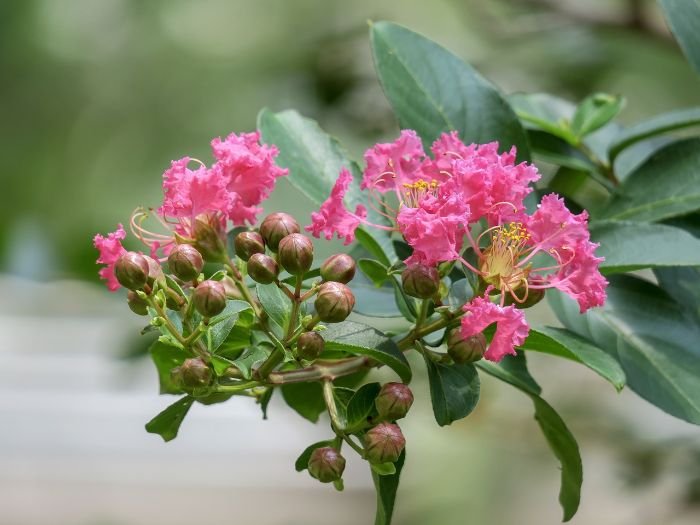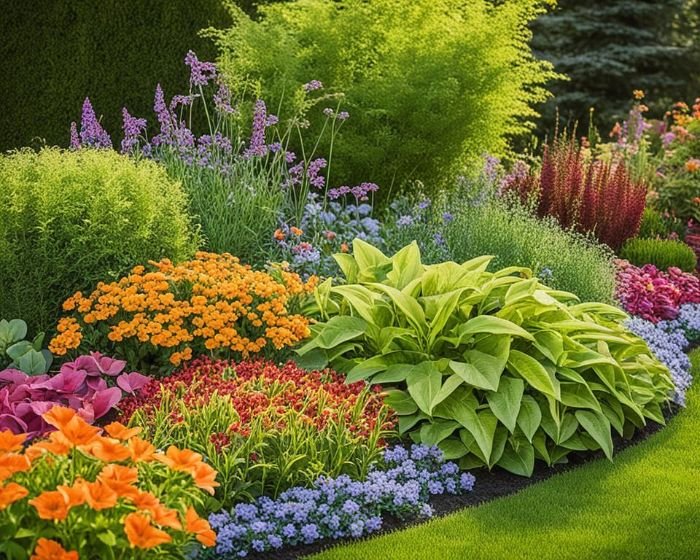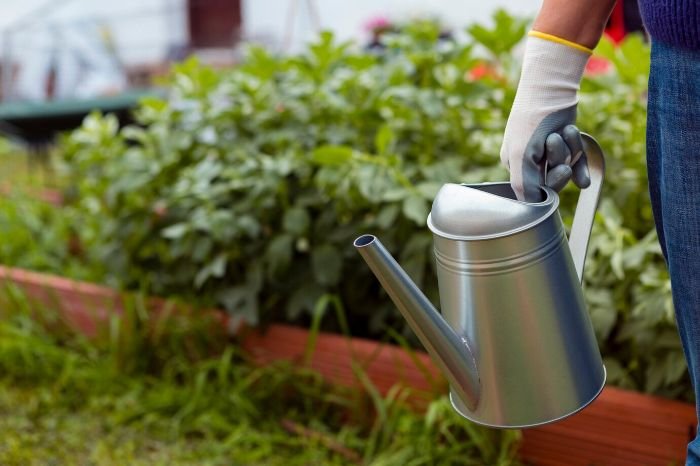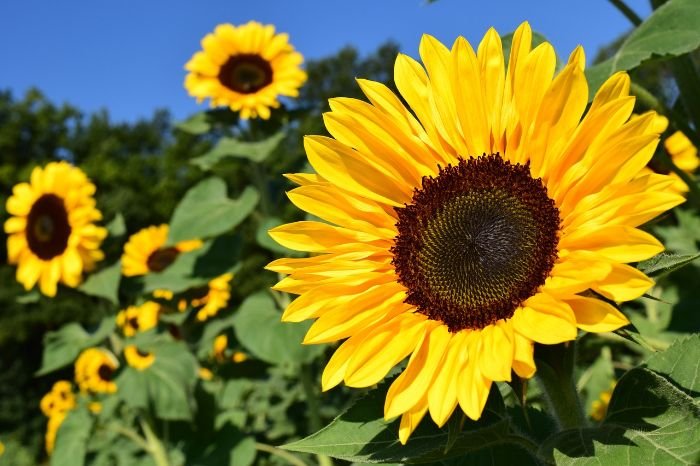Is your sunny garden making it hard to keep plants healthy? Do you see your flowers drooping and your vegetables withering in the sun? It’s vital to pick the right plants for full sun. But, how do you pick ones that love the heat? This section will help you choose plants that thrive in sunny spots. We’ll show you how to make your garden flourish even in the brightest areas.
Not every plant can handle full sun. Some do well in the bright, sunny conditions. Others, though, might not make it and could end up wilting. Knowing which plants love the sun and which don’t is key. It helps you make smart choices for your garden.
Key Takeaways:
- Choosing the right plants for sunny spots is crucial for a healthy garden.
- Some plants can’t handle the intense heat and light of full sun areas.
- Picking sun-loving plants ensures your garden will have bright flowers, strong growth, and good crops.
- Understanding the upsides and downsides of gardening in full sun helps you decide wisely for your sunny garden.
- Keep reading to learn more about plants that thrive in full sun. We’ll help you find the best ones for your sunny garden.
Table of Contents
About Gardening in Full Sun Areas
Gardening in full sun areas is a rewarding, but tricky, task. Many plants love the sun and grow well in it. They show off bright colors and grow big. However, too much sun can be harmful, making it important to know how to deal with heat and keep the plants watered. With the right knowledge, you can make a beautiful garden even in the sunniest spots.
Benefits of Full Sun for Certain Plants
Plants in full sun get the light they need to thrive. This light helps them grow strong, colorful, and make more fruits. They get the energy to grow fast and stay healthy. Also, the sunlight makes their colors look even more beautiful, making a garden a lovely place to be.
Overview of Challenges in Full Sun Gardening
Gardening in full sun is great, but it has its challenges. Plants can get too hot in the sun, which is not good for them. Also, the sun makes the water in the soil dry up faster. This means you have to water plants more often. Knowing how to balance these issues is key to having a thriving garden in full sun.
Best Flowering Plants for Full Sun
Choosing the right flowering plants is important for a bright garden in full sun. You can pick between annuals, which live for a year, or perennials, which come back every year. Both types offer beautiful flowers and do well in the sun.
Popular Annuals and Perennials for Sunny Spots
Annuals bring quick color to your garden. They bloom all season before completing their life cycle. Marigolds, petunias, zinnias, and sunflowers are great for sunny areas. They love the sun and can handle dry heat well.
Perennials, on the other hand, bloom year after year. They add long-lasting beauty to any garden, especially those in sunny spots. Coneflowers, daylilies, black-eyed Susans, and lavender are popular choices. They have beautiful flowers, and they are strong in sunny conditions.
Care Tips for Maintaining Vibrant Blooms
For your flowers to keep blooming brightly in full sun, they need the right care. Here’s what you need to do to keep your garden sunny and colorful:
- Give your plants enough water regularly to fight off the sun. Make sure the soil is moist, not wet.’
- Put mulch around your plants to keep the soil moist, stop weeds, and keep the ground at the right temperature. You can use wood chips or straw.
- Trim off old flowers to help new ones grow. This process, known as deadheading, keeps your plants blooming all season.
- Fertilize regularly to help your plants grow strong and keep producing bright flowers. Use a fertilizer made for flowers and follow the directions.
- Watch for bugs and diseases. Catching these early can help save your plants from harm.
Use these care tips in your garden to make sure your flowers are healthy and colorful.
Hardy Shrubs and Trees for Full Sun
In full sun areas, picking the right plants is key. You want shrubs and trees that love bright places. These types bring beauty to your garden and help wildlife. We’ll look at the best ones that can handle the sunlight. And we’ll talk about how to keep them healthy.
Drought-Tolerant Varieties Ideal for Bright Locations
It’s important to choose plants that don’t need a lot of water for sunny spots. Agave is one choice, with its unique looks. Another great pick is the Crape Myrtle, which has pretty flowers.

You can also try the Yucca, Russian Sage, and Juniper. They thrive under the sun and add character to your garden.
Long-Term Care and Maintenance Strategies
Choosing the right plants is just the start. They need care to stay healthy.
- Watering – Even drought-tolerant plants need water at first.
It’s best to water deeply but not too often. Let the soil dry out between times. - Pruning – Keep your plants in good shape by trimming them. Do this in the quiet seasons. It keeps them strong and removes unhealthy parts.
- Fertilizing – Give your plants food by using a slow-release fertilizer. This helps them grow and stay strong all season.
- Mulching – A layer of mulch helps the soil stay moist, stops weeds, and keeps it from getting too hot or cold. Put it by the plant’s base.
- Pest and Disease Control – Watch out for bugs and diseases. Catching them early keeps your plants from getting hurt.
Following these steps will help your plants do well in sunny areas.
Vegetables and Herbs That Love the Sun
In this section, we will talk about plants that do well in full sun. Picking the right plants for a sunny spot is key to a good harvest. But not every plant can take the intense sunlight, so choose wisely.
Best Choices for a Sunny Vegetable Garden
For full sun, you have many tasty vegetable options. Tomatoes, peppers, eggplants, and zucchini are great warm-season picks. These not only love the sun but are fine with the heat full suns bring.
You can also grow kale, spinach, and lettuce if you water them well. Other veggies like corn, beans, and cucumbers do great in sunny spots. They need the sun to grow big and tasty.
Watering and Feeding Tips to Boost Yield
Plants in full sun need lots of water to avoid drying out. Use drip irrigation or soaker hoses for deep, consistent watering. This way, water doesn’t just evaporate but goes straight to the roots.
Feeding your plants with a balanced fertilizer is also crucial. Organic choices like compost or aged manure are perfect. Follow the instructions on the fertilizer, and be careful not to overdo it to avoid plant damage.
Succulents and Cacti for Full Sun Gardens
Succulents and cacti are great for sunny gardens. They can handle hot, dry weather well. Plus, they bring interesting shapes and textures without needing lots of attention.
Selecting the Right Succulents for Hot Areas
Picking the best succulents for sunny spots is important. You should choose ones that love the sun and can handle heat. Good choices include Agave, Aloe, Echeveria, Sedum, and Crassula. These plants do well in bright sunlight and high temperatures.
Minimal Care Requirements for Maximum Impact
Succulents and cacti are easy to care for. They do best in soil that drains well to avoid waterlogged roots. Only water them when the soil is dry. Deep, sparse waterings work best for these plants.
Feed your succulents now and then during their growing time. Use a balanced fertilizer for succulents. Follow the directions carefully to avoid problems from too much fertilizer.
Cut off any dead or sickly leaves to keep your plants healthy. Doing this often helps you notice and fix problems early. This keeps your garden looking its best.
With a few good choices and some basic care, succulents and cacti can do really well in sunny spots. They will make your garden look beautiful and unique.
Ground Cover Plants for Sun-Drenched Gardens
In gardens with lots of sun, picking the best ground cover plants is crucial. The right ones will make your landscape look beautiful with less work. They also help in many ways in areas with a lot of sunlight.
Effective Coverage with Drought-Resistant Ground Covers
Ground covers that can handle a lot of sun and not much water are perfect for these gardens. They come in many types, like those with succulent leaves. These choices don’t need a lot of water to stay green. So, they look good even when it’s very hot outside.

Benefits of Using Ground Covers in Full Sun
There are many good things about using ground covers in sunny spots. For one, they keep the soil moist by blocking the sun and stopping water from disappearing too fast. They also stop weeds from growing a lot, meaning less work for you. Plus, they keep the soil in place, so it doesn’t wash away in rain or strong wind.
Choosing drought-resistant ground covers is a smart move for sunny gardens. They make your landscape full and pretty while needing less water and care. They are a great choice for places where grass can’t grow well. Or, if you want a garden that looks different and charming.
Planting Techniques for Sun-Exposed Gardens
For gardens that get a lot of sun, how you plant is key. Doing it right helps your plants do well in bright, sunny spots.
Best Practices for Planting in Sunny Conditions
When you plant in sunny places, stick to these top tips:
- Choose sun-loving plants – Pick plants that love the sun. They should be able to handle lots of sun and heat without a problem.
- Ensure proper spacing – Make sure your plants have enough room. They need space to get all the sunlight and air they need. Too many plants close together can get sick more easily.
- Provide sufficient water – Sunny areas can dry out fast, so give your plants plenty of water. Check the soil often and water when needed to keep them healthy.
- Apply mulch – Mulch helps keep the soil moist, stops weeds, and keeps the ground from getting too hot. Put a layer of mulch like wood chips or straw around each plant.
- Implement proper care – Make sure you look after your plants well. This means giving them the right food, trimming them when needed, and keeping bugs away. Always check how your plants are doing and help them if they look sad or sick.
Follow these tips to make a stunning garden that loves the sun.
How to Prepare Soil for Heat-Loving Plants
To get your sunny garden ready for heat-loving plants, prep the soil right. Here’s what to do:
- Test and amend the soil – Test the soil to see if it’s good for your plants. Make it better by adding things like compost or organic matter. This makes the soil healthier and more plant-friendly.
- Ensure proper drainage – Most plants that like heat need soil that drains well. If your soil holds too much water, mix in things like sand or perlite. This helps with drainage.
- Provide adequate nutrients – These plants need a lot of food. Use organic or slow-release fertilizers to keep them nourished all season long.
- Consider raised beds or containers – If the soil isn’t right, try gardening in raised beds or pots filled with special soil. It gives you more control over the soil’s quality.
By doing this, you’ll give your heat-loving plants the best home in your sunny yard.
Water Management for Full Sun Plants
To keep your plants healthy in full sun, you need to manage water well. The strong sun can make plants dry up fast. So, you should water them right and use mulch to keep the soil moist.

Irrigation Strategies to Combat Intense Sunlight
Watering full sun plants just enough is key. Here are some smart ways to water them:
- Deep Watering – Water them deeply less often. This helps plants grow strong roots to find water deep down. They become more resistant to the sun’s drying heat.
- Drip Irrigation – Drip systems water plants at the roots, which uses less water. It’s great for sunny areas, saving water and preventing runoff.
- Watering in the Morning – Morning watering lets plants drink up before it gets too hot. They have all day to use the water before it goes away.
Mulching Techniques to Retain Soil Moisture
Mulch holds water in the soil and stops it from drying out in the sun. Here’s how to do it right:
- Organic Mulch – Use materials like wood chips or straw around your plants. It keeps the soil cool, stops water from leaving, and feeds plants as it rots.
- Plastic Mulch – In some areas, you can use plastic to keep water from just leaving the soil. This is good for veggies and flowers that need a lot of water.
- Strategic Placement – Put mulch everywhere under the plants, not just near their trunks. It keeps the soil moist and helps plants suck up all the water they can.
Using these tips will help your sunny plants get the water they need without too much worry. Check the soil and adjust your watering as your plants ask for more or less. With good water thinking, your sunny garden will be happy and healthy.
Mitigating Heat Stress in Full Sun Plants
Heat stress is tough on plants that love full sun. They can be hurt by high temps and strong sun. Yet, you can make adjustments to help these plants beat the heat.
Signs of Heat Stress and How to Address Them
Knowing the signs of heat stress is key. Look for wilting, curling leaves, browning or yellow spots, and slow growth. If you see these, act fast to help your plants.
To fight heat stress, do these things:
- Provide sufficient water – Plants lose more water when it’s hot. So, make sure they get plenty of water. It’s better to water deeply but less often than lightly all the time.
- Provide shade or protect from direct sunlight – In extreme heat, give your plants a break from direct sun. Use shade cloths or umbrellas to keep them cool.
- Mulch – Spread mulch around your plants to hold in moisture. This also stops weeds and keeps the soil cooler.
- Prune strategically – Cut off damaged or wilting leaves to help your plant grow new ones. Pruning also boosts air around the plant to lower stress.
Adjustments for Unexpected Heat Waves
Heat waves are extra tough on plants in hot areas. Stay prepared to keep your plants safe.
To protect your plants during heat waves, do this:
- Increase watering – Your plants will need more water in a heatwave. Check the soil often and water more if it’s too dry.
- Provide additional shade – Make cover for your plants with shade structures or cloths in peak sun hours.
- Use reflective mulch – Consider using mulch that reflects sunlight. It helps keep the soil cooler, which helps your plants.
- Mist your plants – A light spraying of water can cool down plants and help them through the hot day.
By staying ahead and using these tips, you can keep your full sun plants healthy. They’ll do well even when the weather is tough.
Designing a Full Sun Garden
In this part, we’ll look at how to design a pretty and working full sun garden. A great garden makes your outdoor area look good and helps plants grow in sunny spots.
Layout Ideas for Aesthetic and Functional Sun Gardens
Think about plant layout when designing your sunny garden. It should not only look nice but also be practical. Here are some ideas to help you get started:
- Create focal points – Use statues, water features, or colorful plants to catch the eye and make your garden interesting.
- Group plants strategically – Place plants with the same light and water needs together for better care and growth.
- Utilize vertical space – Add trellises, arbors, or tall plants to make your garden look bigger and more interesting.
- Create pathways – Use stepping stones, gravel, or pavers to create paths that lead visitors through your garden.
- Consider color schemes – Pick plants with colors that work well together or stand out to make your garden vibrant and dynamic.
Incorporating Shade Elements Where Necessary
Full sun gardens love lots of light but some plants need shade. Here’s how to add shade to your sunny space:
- Use pergolas or shade sails – Put up structures that give partial shade, so you can adjust sunlight as needed.
- Plant shade trees – Plant trees in the right spots to keep delicate plants cool or to create shaded sitting areas.
- Use umbrellas or shade cloth – Add umbrellas or shade cloth above seating areas for a break from the sun.
- Utilize containers – Grow heat-loving plants in pots you can move to shady spots when needed.
Adding shade where it’s needed lets you create different plant environments within your full sun garden. It helps more types of plants thrive.
Conclusion – Thriving Plants in Full Sun Environments
Selecting the right plants, using proper care, and making your garden beautiful are key. This ensures your plants do well in sunny spots. With a little planning, you can have a garden that’s lively and beautiful.
Start by picking plants that love the sun. They should be able to handle lots of light. With the right sun-loving plants, your garden will start off strong.
How you take care of your garden matters a lot. Watch how much you water, especially when it’s hot. Using things like drip irrigation can help your plants stay healthy.
Mulching can also make a big difference. It keeps the ground moist and helps stop weeds. This can make your sunny garden even better.
Making sure your garden looks good and is useful is important too. Think about where everything will go. Add shady spots to make it a nice place for everyone, plants and people alike.
By doing all these things, your sunny garden can become a lovely, colorful space. Watch as your plants grow beautifully in the sunshine. This will make your outdoor area a place of happiness and peace.
FAQ
What are the benefits of gardening in full sun areas?
Gardening in full sun areas boosts plant growth and colorful flowers. This much sunlight gives plants the needed energy. They grow healthy and strong.
What challenges can I expect when gardening in bright and sunny locations?
Full sun can create problems like too much heat and not enough water. Overheating and dry soil need extra water. Managing water becomes crucial.
Which flowering plants thrive in full sun areas?
Sunflowers, marigolds, and lavender love full sun. They offer a bright splash of color in your garden.
How can I care for flowering plants to maintain vibrant blooms in full sun areas?
To keep your flowers looking great, water, deadhead, and fertilize regularly. Good spacing and soil prep are also key for growth.
What are some ground cover plants that are suitable for full sun areas?
Ground covers like creeping thyme and ice plant are perfect for full sun. They not only look good but also help save water and keep weeds away.
How can I manage water effectively for plants in full sun areas?
Use drip irrigation or mulching to keep plants watered. Mulch helps keep soil moist and stops water from evaporating.










